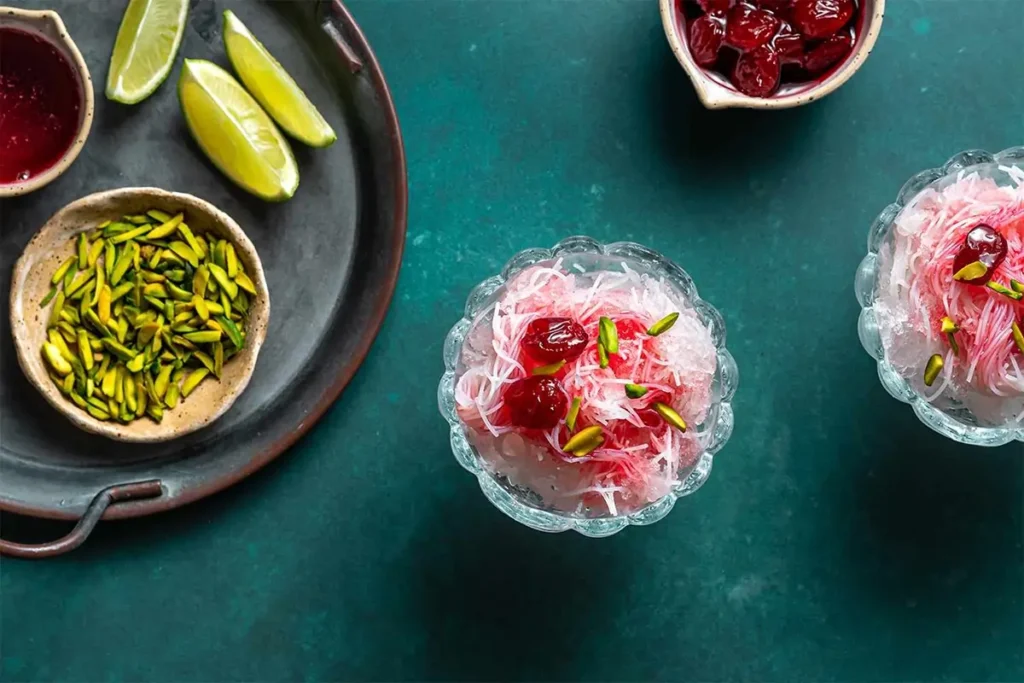
8 Persian deserts you don’t want to miss
Iranian cuisine, deeply rooted in the traditions of one of the oldest countries in the world, is celebrated for its vibrant flavors, aromatic spices, and artful presentation. While savory dishes like Kabab Koobideh (grilled minced meat kebabs) and Ghorme Sabzi (herb and meat stew) often steal the spotlight, Persian desserts are an equally integral part of Iranian culture, offering a sensory experience that reflects the nation’s heritage, hospitality, and creativity.
These sweets, infused with poetic elegance and historical significance, showcase the ingenuity of Iranian famous figures like chefs, poets, and artisans who have shaped the country’s culinary legacy. In this comprehensive exploration, we’ll dive into the history, ingredients, regional variations, cultural significance, and modern adaptations of Persian desserts, weaving in the essence of Iranian cuisine and the enduring spirit of one of the oldest countries in the world.
A Historical Sweet Journey Rooted in Iranian Culture
Iran’s culinary traditions trace back to the Achaemenid Empire (550–330 BCE), a period when Persia was a global hub along the Silk Road. This strategic position facilitated the exchange of ingredients like saffron, pistachios, and rosewater, which became cornerstones of Iranian cuisine.
Persian desserts, were born from this rich cultural tapestry, blending local abundance with influences from India, China, and the Mediterranean. Iranian culture revered food as an art form, with sweets playing a central role in Zoroastrian rituals, seasonal festivals like Nowruz (Persian New Year), and royal banquets during the Safavid dynasty (1501–1736).
Iranian famous figures like the poet Rumi, whose verses often drew parallels between food and spiritual nourishment, and medieval scholars like Avicenna, who documented the medicinal properties of ingredients like saffron, indirectly shaped the evolution of Persian desserts.
These sweets were not just indulgences but symbols of abundance, joy, and community, served during celebrations, weddings, and even memorials. Today, they remain a testament to Iran’s enduring legacy as one of the oldest countries in the world, preserving recipes that have delighted palates for millennia.
The Essence of Persian Desserts: Ingredients and Philosophy
The philosophy of Iranian cuisine, including its desserts, emphasizes balance—flavors that harmonize without overwhelming, textures that contrast, and presentations that reflect the aesthetic sensibilities of Iranian culture. Persian desserts combine sweet, tart, and aromatic elements. Key ingredients include:
- Saffron: Known as “red gold,” this spice, harvested in Iran’s Khorasan region, imparts a golden hue and earthy flavor, used in desserts.
- Rosewater and Orange Blossom Water: Floral essences that evoke Persian gardens, adding a poetic touch to sweets.
- Nuts: Pistachios, almonds, and walnuts provide crunch and richness, often ground or slivered, mirroring their use in savory Iranian dishes.
- Spices: Cardamom and cinnamon add warmth
- Sweeteners: Honey and sugar syrups, often infused with aromatics, create a glossy finish, akin to the glazes used in some Persian rice dishes.
- Flours: Rice flour, chickpea flour, and wheat flour form delicate bases, similar to the starches in some Iranian cuisine recipes.
- Fruits: Pomegranates, dates, and barberries add tartness.
- Dairy: Milk and cream, often thickened with salaab (orchid root extract), lend creaminess, a nod to the richness of Persian stews.
This balance reflects the ingenuity of Iranian famous figures like traditional chefs who perfected recipes over centuries, ensuring that desserts, like savory dishes, embody the harmony central to Iranian culture.
Iconic Persian Desserts
Let’s explore some of the most beloved Persian desserts, their preparation, regional variations, and their role in Iranian culture.
- Faloodeh: A Refreshing Legacy
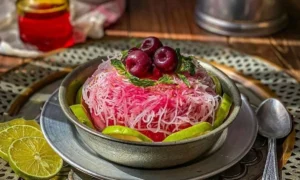
Faloodeh, one of the world’s oldest frozen desserts, hails from Shiraz, a city celebrated in Iranian culture for its poetry and gardens. This sorbet-like treat, predating ice cream, features thin rice or starch noodles soaked in a chilled syrup of sugar, rosewater, and saffron, often served with lime juice or sour cherry syrup.
- Texture and Flavor: The chewy noodles contrast with the icy, floral-tart syrup, offering a lightness akin.
- Cultural Significance: In Iranian culture, faloodeh is a summer favorite and a Nowruz staple, symbolizing renewal. Its ancient origins tie it to one of the oldest countries in the world.
- Preparation: Rice vermicelli is cooked, chilled, and mixed with a syrup of sugar, water, rosewater, and saffron. The mixture is frozen until slushy and served with tangy toppings.
- Regional Variations: Shiraz’s faloodeh is tart and minimalist, while Yazd’s may include mint or fruit infusions, reflecting the diversity of persian dishes.
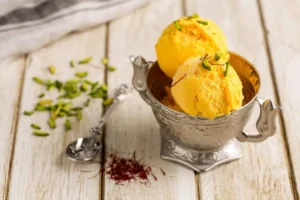
Bastani, or saffron ice cream, is a creamy delight infused with saffron, rosewater, and pistachios, with a stretchy texture from salaab. Often served with faloodeh or between wafers, it’s a luxurious treat.
- Texture and Flavor: Creamy yet chewy, with saffron’s warmth and pistachios’ crunch.
- Cultural Significance: Bastani is a nostalgic dessert in Iranian culture, evoking childhood memories and festive gatherings. Its saffron ties it to Iran’s agricultural heritage as the oldest country in the world.
- Preparation: Milk is heated with sugar, saffron, rosewater, and salaab, then churned and folded with pistachios before freezing.
- Modern Twists: Chefs inspired by Iranian famous figures like modern culinarians add flavors like cardamom or vanilla.
- Halva: A Symbolic Sweet
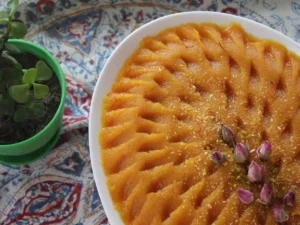
Persian halva, made from toasted wheat flour, butter, sugar, and rosewater, is a fudge-like confection distinct from sesame-based versions.
- Texture and Flavor: Smooth and rich, with cardamom’s warmth.
- Cultural Significance: In Iranian culture, halva is served at funerals and religious ceremonies, symbolizing remembrance. Its shared preparation reflects the communal spirit of the oldest country in the world.
- Preparation: Flour is toasted in butter, mixed with a sugar-rosewater syrup, and garnished with nuts.
- Regional Variations: Bushehr’s halva may include dates, while Tabriz’s is denser, showcasing Iranian cuisine’s diversity.
- Zoolbia and Bamieh: Festive Fritters
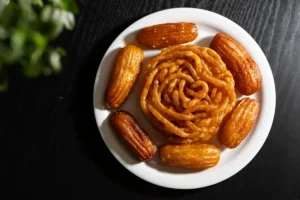
Zoolbia (lacy fritters) and bamieh (cylindrical doughnuts) are deep-fried pastries soaked in saffron-rosewater syrup, akin to the glossy finishes in some Iranian cuisine dishes.
- Texture and Flavor: Crispy yet syrupy, with floral notes.
- Cultural Significance: A Ramadan staple in Iranian culture, these sweets are shared during iftar, reflecting hospitality.
- Preparation: A flour-starch-yogurt batter is fried in intricate shapes or logs, then soaked in warm syrup.
- Regional Variations: Isfahan’s zoolbia is crispier, while Mashhad’s bamieh may include cardamom.
- Shirini Nokhodchi: Clover Cookies
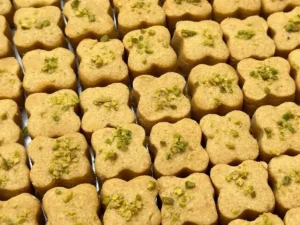
These chickpea flour cookies, flavored with cardamom and topped with pistachios, are a Nowruz favorite.
- Texture and Flavor: Crumbly and nutty, with a delicate sweetness, they evoke the subtlety of Iranian cuisine.
- Cultural Significance: Symbolizing prosperity in Iranian culture, these cookies are shared during Persian New Year, tying to the traditions of the oldest country in the world.
- Preparation: Chickpea flour, sugar, butter, and cardamom are kneaded, shaped into clovers, baked, and garnished.
- Modern Twists: Some add rosewater, inspired by Iranian famous figures in modern baking.
- Sohan: Qom’s Brittle
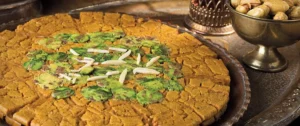
Sohan, a toffee-like brittle from Qom, is made with wheat germ, butter, sugar, saffron, and pistachios.
- Texture and Flavor: Crisp and buttery, with saffron’s elegance, it’s a luxurious treat.
- Cultural Significance: A pilgrimage souvenir in Iranian culture, sohan reflects Qom’s spiritual significance.
- Preparation: Butter, sugar, wheat germ, and saffron are cooked, spread thin, and topped with nuts.
- Variations: Sohan halva is chewier, showcasing Iranian cuisine’s versatility.
-
Ranginak: Southern Sweetness
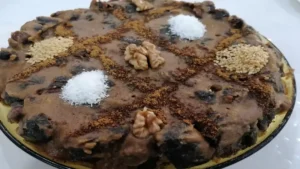
Ranginak, from southern Iran, features dates stuffed with walnuts, layered in toasted flour and butter, and dusted with cinnamon.
- Texture and Flavor: Soft dates, crunchy walnuts, and buttery flour create a rich balance.
- Cultural Significance: A winter favorite in Iranian culture, ranginak fosters family connections.
- Preparation: Dates are stuffed with walnuts, layered over a flour-butter mixture, and garnished.
- Regional Variations: Khuzestan adds sesame, reflecting regional Persian cuisine.
- Lesser-Known Gems.
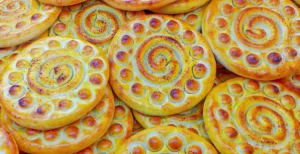
- Koloocheh: Stuffed cookies from Gilan, filled with walnuts and cinnamon.
- Sheer Berenj: Rice pudding with rosewater and saffron.
- Poolaki: Translucent sugar candies from Isfahan, served with tea in Persian culture.
- Qottab: Yazd’s almond-filled pastries, showcasing the artistry of one of the oldest countries in the world.
Cultural Significance in Iranian Culture
Persian desserts are a cornerstone of Iranian culture, embodying hospitality and connection. Sweets like shirini nokhodchi and sohan grace Nowruz tables, symbolizing prosperity. During Ramadan, zoolbia and bamieh unite communities, while halva fosters remembrance at memorials.
Iranian famous figures like Hafez, whose poetry inspired festive gatherings, indirectly elevated the role of desserts in cultural rituals. As the oldest country in the world, Iran’s dessert traditions reflect a deep respect for heritage and community.
Regional Diversity and Iranian Cuisine
Iran’s vast geography shapes its desserts, much like its savory dishes. Northern koloocheh uses local walnuts, southern ranginak highlights dates, and central Isfahan’s poolaki showcases precision. This diversity underscores Iranian cuisine’s richness and the cultural mosaic of one of the oldest countries in the world.
Modern Adaptations and Global Influence
Modern chefs, inspired by Iranian famous figures like cookbook authors Ariana Bundy and Najmieh Batmanglij, are reimagining Persian desserts. Faloodeh-inspired sorbets now feature mango, while bastani appears in gelato form. The Persian diaspora has introduced these sweets to cities like Los Angeles and Toronto, where bakeries serve zoolbia. Social media amplifies their global appeal, with vibrant images of saffron-hued sweets captivating foodies.
Recipes to Try at Home
Faloodeh
- Ingredients: 1 cup rice vermicelli, 1 cup sugar, 2 cups water, 1/4 cup rosewater, 1 tsp saffron, lime juice.
- Instructions:
- Cook vermicelli for 2–3 minutes, rinse in cold water.
- Boil sugar, water, rosewater, and saffron to make syrup; cool.
- Mix noodles with syrup, freeze for 2–3 hours, stirring for a slushy texture.
- Serve with lime juice, inspired by Iranian cuisine’s tangy notes.
- Tip: Use a sieve for homemade noodles, a nod to the oldest country in the world.
Shirini Nokhodchi
- Ingredients: 2 cups chickpea flour, 1 cup powdered sugar, 1 cup butter, 1 tsp cardamom, pistachios.
- Instructions:
- Mix flour, sugar, and cardamom.
- Knead in butter, shape into clovers, and top with pistachios.
- Bake at 325∘F325^\circ F325∘F (163∘C163^\circ C163∘C) for 15–20 minutes.
- Cool and serve, reflecting Iranian culture’s elegance.
Note: Consult a professional for precise techniques, especially for deep-frying or saffron use, as in Iranian cuisine.
Conclusion
Persian desserts, are a vibrant expression of Iranian cuisine and Iranian culture. From faloodeh’s icy refreshment to sohan’s buttery crunch, they embody the artistry of the oldest country in the world. Influenced by Iranian famous figures and centuries of tradition, these sweets invite you to savor Iran’s heritage. Whether shared at a Nowruz feast or enjoyed globally, Persian desserts are a delicious bridge across time and culture.
FAQs About Persian Desserts
-
What makes Persian desserts unique in Iranian culture?
They blend floral, nutty, and spiced flavors, reflecting Iran’s ancient culinary heritage and hospitality.
-
What are common ingredients in Persian desserts?
Saffron, rosewater, pistachios, almonds, cardamom, and dates are staples.
-
What is Faloodeh, and why is it popular?
Faloodeh is a chilled dessert of rice noodles in rosewater-saffron syrup, loved for its refreshing taste in Iranian cuisine.
-
How do Persian desserts tie to Iranian festivals?
Desserts like shirini nokhodchi are served during Nowruz, symbolizing prosperity in the oldest country in the world.
-
Are there regional variations in Persian desserts?
Yes, Shiraz’s faloodeh is tart, while Yazd’s qottab is nut-filled, showcasing Iranian cuisine’s diversity.
-
How have Iranian famous figures influenced desserts?
Poets like Rumi and modern chefs like Najmieh Batmanglij have inspired their cultural and culinary significance.

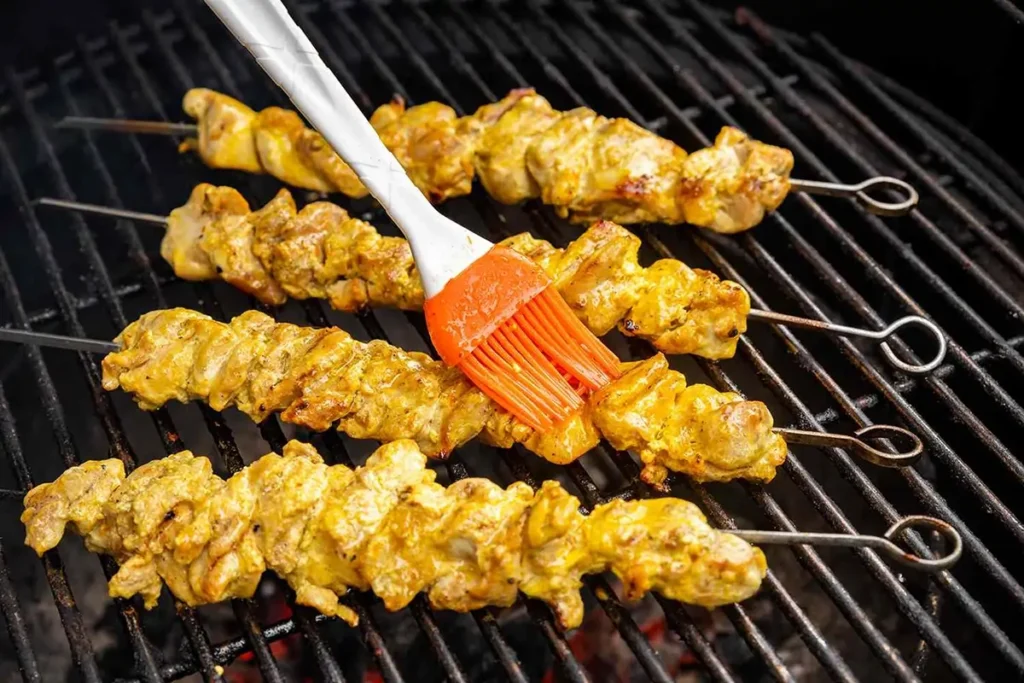
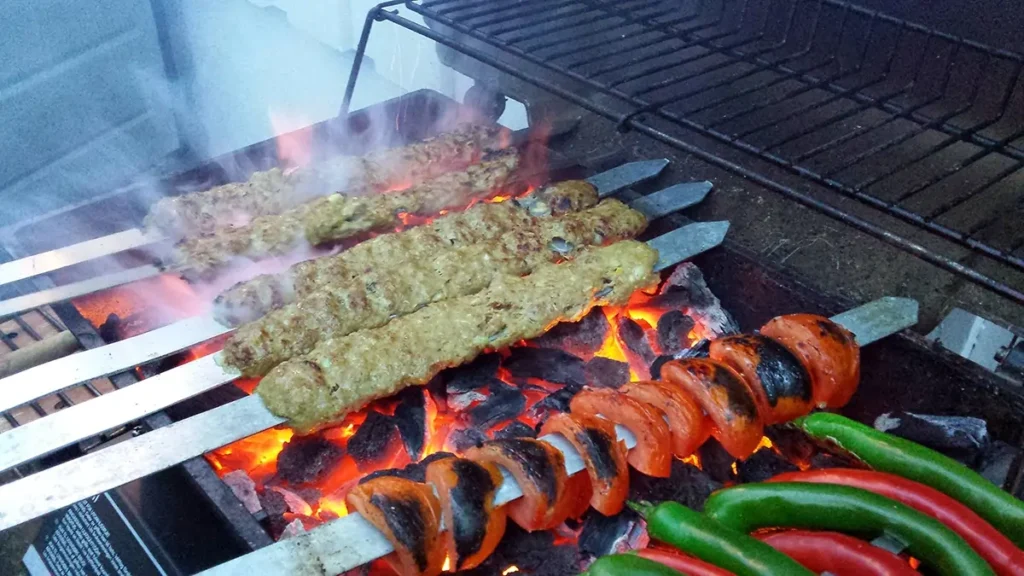
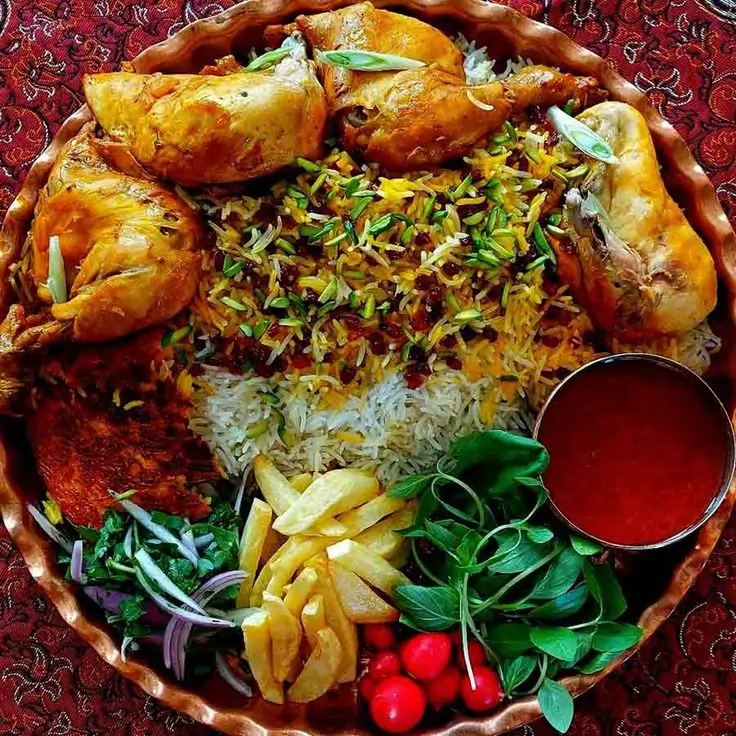
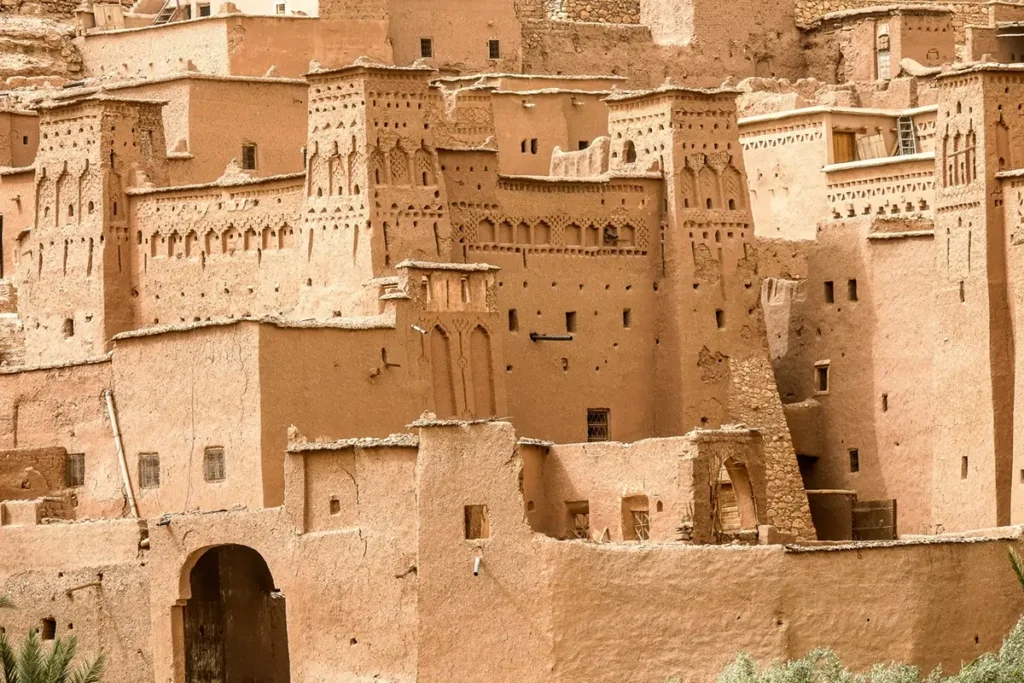
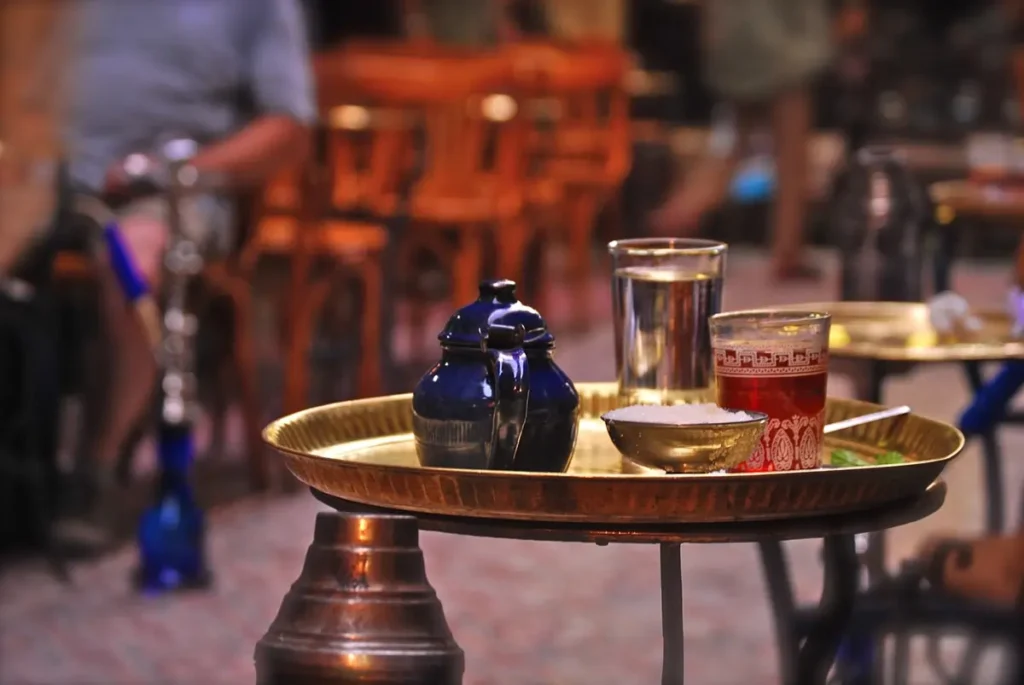
Thanks alot for the recipies, I have heard alot about an Iranian desert called Gaz. Can you write an article about that?
Thank You Adi for your nice comment, sure I will.